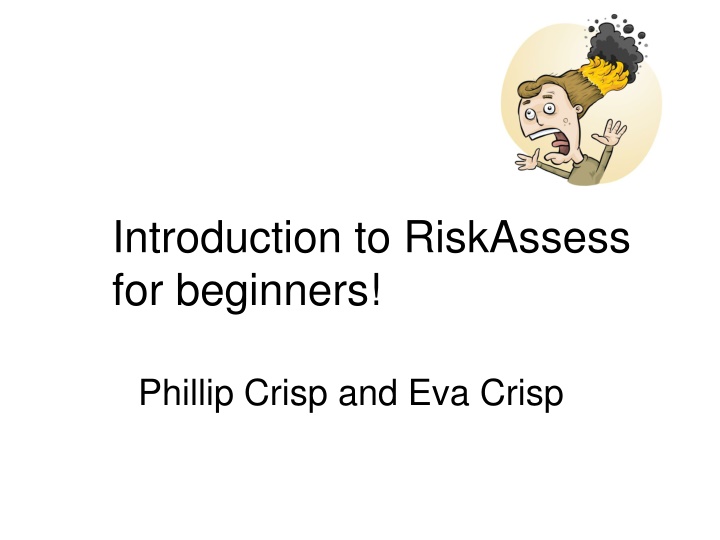
Introduction to Risk Assessment for Beginners - Key Guidelines and Practices
Explore the essential aspects of risk assessment for beginners, covering legal obligations, risk identification, assessment, control measures, and monitoring. Learn how to manage risks effectively and ensure safety in various environments.
Download Presentation

Please find below an Image/Link to download the presentation.
The content on the website is provided AS IS for your information and personal use only. It may not be sold, licensed, or shared on other websites without obtaining consent from the author. If you encounter any issues during the download, it is possible that the publisher has removed the file from their server.
You are allowed to download the files provided on this website for personal or commercial use, subject to the condition that they are used lawfully. All files are the property of their respective owners.
The content on the website is provided AS IS for your information and personal use only. It may not be sold, licensed, or shared on other websites without obtaining consent from the author.
E N D
Presentation Transcript
Introduction to RiskAssess for beginners! Phillip Crisp and Eva Crisp
THE LAW? Work Health & Safety Act 2011 . . . a duty . . . to eliminate/minimise risks to health and safety as far as is reasonably practicable. . . . taking into account and weighing up all relevant matters including: (a) the likelihood of the hazard or the risk concerned occurring; and (b) the degree of harm that might result from the hazard or the risk . . . . Part 2, Sections 17 and 18
all relevant matters includes facilities available behaviour of the class students with special needs students with allergies, etc (NOT book risk assessment , tick sheet, etc) likelihood degree of harm consideration requires proper risk assessment using a risk matrix e.g. Aust/ISO Standard on Risk Management
You should: identify assess control risks Before: Establish the context After: Monitor and review Always: Consult and communicate
Risk identification history of accidents and near-accidents - at school - at similar schools brainstorming, preferably with colleagues checklists of possible risks authoritative sources e.g. SDSs, databases
Risk assessment To assess the severity of a risk, you need to consider: the consequences of the event, and the chance that it will occur (likelihood) AU ISO 31000:2009 Risk management HB 436:2013 Risk management guidelines Risk matrices used in schools are 3 x 3 to 5 x 5 See www.riskassess.com.au/info/learning_resources
Risk control Hierarchy of options: elimination substitution isolation engineering administration personal protective equipment
Assess risks Low Medium risk level risk level Add control measures DO EXPERIMENT Inherent level of risk = risk level without any control measures besides routine procedures Residual level of risk = risk level with control measures in place
What is RiskAssess? web-based risk assessment tool customised to the school situation provides - electronic templates (AU/ISO) - database information on risks (chemical, equipment, biological) - equipment ordering/lab scheduling - labelling (GHS) - learning resources easy sharing of experiment templates for customisation
Logic separate sections for teacher and laboratory technician initial assessment of inherent risk - if low, go to end - if medium or more, record control measures - if high or extreme, third reviewer required cross-checking by teacher/labtech/reviewer scheduling, ordering, labelling to save time inexpensive ($250+GST per campus per year)
Details access from school/home nothing to install on computer, tablet or phone (instant update) unlimited number of simultaneous users and risk assessments minimal data entry complements SDSs continuing input from science staff multiple backups of data & backup server support and advice
Advantages of risk assessments reduced frequency of injuries - to students - to school staff reduced costs for paperwork, litigation and payouts compliance with the law helps maintain variety of chemicals and equipment compliance with the Queensland Curriculum
Advantages of a formalised system proper consideration of risks and control measures standardisation storage of records for legal purposes communication between teachers and laboratory technicians discourages spur-of-the-moment experiments useful for new/inexperienced staff
Paper-based system time consuming unwieldy forms non-searchable difficult to update storage problems
Electronic system relatively rapid prompts sensitive to context reduces paper consumption easy to review and update easy monitoring and statistics easy storage demonstrated to work in schools RiskAssess: 1800 schools AU+NZ+CA 2,400,000 risk assessments
Even more! scheduling system prac ordering GHS labelling - standard - customised
Summary of benefits safer laboratories better communication meets legal requirements reduced costs improved efficiency happy lab techs and teachers!
Student RiskAssess meets safety training requirements of - new Australian Curriculum for Science - International Baccalaureate - extended investigations (student-initiated) optimised for student use - students must agree to follow rules and instructions - online help screens and documents - PINs to prevent copying/allow use for assessment continues to have all facilities of RiskAssess class of 30 simultaneous users no problem can be used on - laptops, iPads and other tablets - smart phones (iPhones, Android, etc) costs an additional $250 + GST per campus per year






















